Solving the Lack of Housing in Marin: Implementing Senate Bill 9 (SB 9)
The California Housing Opportunity and More Efficiency (“HOME”) Act, also known as SB 9, paves the way to increased housing in residential Marin neighborhoods.
California needs more affordable housing, estimated to be 2-3 million new homes by 2025. The law focuses on more housing in single-family neighborhoods. Almost 66% of all California residences are single-family housing and nearly 75% of all developable land is zoned single-family. The law also protects renters in these properties and prevents developers from unfairly profiting from the increased housing density.
SB 9 Provides Up to Four Housing Units on a Single-Family Lot
SB 9 facilitates the creation of up to four housing units on a lot typically used for one single-family home. The law also allows for subdividing a single-family lot into two parcels, with up to two units on each parcel.
Importantly, SB 9 streamlines and simplifies applications to create additional units or divide a lot for the creation of additional units. Applications must be considered ministerially, without discretionary review or public hearings.
Types of Housing Units
Primary Unit. A primary unit (also called a residential dwelling unit or residential unit) is typically a single-family residence, a duplex (two primary units), and a four-plex (four primary units).
Accessory Dwelling Unit (ADU). An ADU is an attached or a detached residential dwelling unit that provides complete independent living facilities for one or more persons and is located on a lot with a proposed or existing primary residence. It must include permanent provisions for living, sleeping, eating, cooking, and sanitation.
Junior Accessory Unit (JADU). A unit that is no more than 500 square feet in size and contained entirely within a single-family residence. A Junior ADU may include separate sanitation facilities or may share sanitation facilities with the existing structure.
Major Conditions for Adding Housing Units
- The property must be in a single-family residential zone.
- The minimum primary unit size is 800 square feet.
- The property cannot be in a historic zone, on prime farmland, or environmentally protected areas.
- Units are not allowed where they would displace renters and low-income households.
- Units must be used for residential uses only.
- If homeowners split their property, they must occupy one of the units as their primary residence for three years from the time they get approval for a lot split.
- Single family properties may be divided in two (50-50 or 60-40), and the new lots can each accommodate two units, for a total of four.
- If homeowners split their property, they must occupy one of the lots as their primary residence for at least three years.
- One off-street parking space may be required for each unit, unless the parcel is located within one-half mile of a high-quality transit corridor or major transit stop or there is a car share vehicle located within one block of the parcel.
Lot Splits and the Number of Dwelling Units
There has been confusion concerning the provisions in SB 9 to facilitate lot divisions for additional living units. This may provide clarification:
No Lot Split. When a lot split has not occurred, the original lot may have one or two primary units and a combination of ADUs and/or JADUs so long as there are no more than four units in total. For example, a lot could have a primary residence, an internal ADU, a detached ADU and a JADU.
Lot Split. When a lot split occurs, each lot can have up to two units of any of these unit types: primary residence, duplex, ADU, and Junior ADU. For example, each lot could have two primary units, or a primary unit and an ADU or a primary unity and a JADU.
Adding ADUs on Small Lots
Many towns in Marin have single-family homes on lots less than the currently required minimum of 7,500 sq. ft. Can you split the lot and build ADUs on these lots? Since we are close to the Corte Madera Planning department, we started there to find out about small single-family lots. We spoke to a Senior Planner who provided this outline:
- Small lots can be split into two lots and each can accommodate ADUs if the two resulting lots are about the same size and one or both lots is a minimum of 1,200 sq. ft.
- You can build ADUs and Junior ADUs on lots of any size.
- These additions can exceed the required lot coverage and floor area ratio (FAR).
- ADUs from 800 to 1,000 sq. ft. may be built over the normally required setbacks. ADUs of 1,200 sq. ft. require a variance from the town to extend into the setbacks.
Most of these requirements are set by the state law, SB 9. However, each city/town/county jurisdiction has added specific requirements and exceptions. We highly recommend that you talk to a planner in your town to learn more.
Rentals Properties
Proposed SB 9 projects cannot require the alteration or demolition of any rent-controlled or moderate, low, or very low-income housing. Alteration and demolition is also prohibited for any units occupied by a rental tenant within the past three years. Two cities in Marin now have rent control, also called rent stabilization: Larkspur and Fairfax.
Cities’ Responsibilities
- Cities must streamline the permitting process. Applications must receive ministerial approval, a permit process for development approval involving little or no personal judgment by a public official.
- Cities may impose objective zoning, subdivision, and design review standards, for example, restrictions on lot size, setbacks, maximum building size, and building height.
- Cities can exclude the provisions of this act from very high fire hazard severity zones, prime agriculture land, hazardous waste sites, earthquake zones, floodplains that do not have adequate mitigation, and others.
Status of SB 9 in Marin
SB 9 became effective on January 1, 2022. Most cities and Marin County adopted temporary ordinances by 2022 to comply with the new law. Jurisdictions in Marin are in the process of adopting permanent regulations for qualified SB 9 projects. Compliance for the following towns has been variable, with some towns appearing to be very cooperative and others noncompliant.
Here are links to the status for each town and unincorporated areas as of August 2023. Check the town websites for updates.
- Belvedere. Pending
- Corte Madera
- Fairfax.
- Larkspur
- Mill Valley
- Novato
- Ross
- San Anselmo
- San Rafael
- Sausalito
- Tiburon
- Marin County, for homeowners who live in unincorporated areas of the county. This map shows the extensive unincorporated areas of Marin, including those in Greenbrae, Kentfield, Mill Valley, the San Geronimo Valley, Tiburon, and West Marin.
Status of SB 9 in California
A report created by the Tenant Center for Housing Innovation at UC Berkeley (July 2021) on the impact of SB 9 predicted that due to market conditions and other restrictions statewide, about 1.5% of single-family properties would take advantage of the bill (see page 9 of the report).
A report by the Terner Center for Housing Innovation at UC Berkeley (January 2023) on the impact of SB 9 found little or limited progress in applying SB9 in thirteen case cities.
These are some of the issues yet to be resolved:
- Will mortgage lenders accommodate lot splits and changes in land use?
- How will cities deal with SB 9 in areas of high fire risk and special flood hazard areas?
- How will zoning requirements impact the ability to add additional units? Cities have some choices under SB 9. For example, cities can require one parking space for each new unit.
- Are added units financially practical?
More Information
For more information, please see these sites:
- Update in 2025 on new ADU laws.
- SB 9 and the California H.O.M.E Act. Explains SB 9 and answers questions.
- Terner Center for Housing Innovation.
HelloADU. Free ADU feasibility and project management support provided by Marin County.



